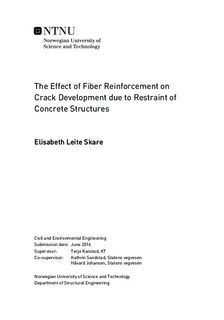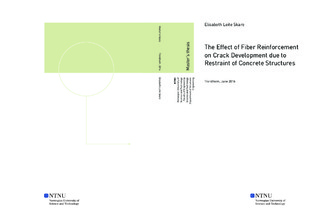| dc.description.abstract | This thesis studies the effect of fiber reinforcement on crack development in concrete structures. Background for choice of subject, is that cracks due to external restraint are observed on many of today's bridges, and it is assumed that fiber reinforcement may limit this crack development. Hence, a laboratory experiment was performed during the summer of 2015, in connection with the specialization project written by the undersigned. The experiment studied the effect of steel fibers and polymer fibers on the crack development, compared to a concrete without fiber reinforcement. In the fiber mixes, one saw a much denser crack development than for the reference concrete, and the crack widths were much smaller in the fiber mixes.
On the initiative of Norwegian Public Roads Administration, it was decided to carry out the same measures to reduce cracks on a real bridge. This full-scale experiment has been conducted in connection with this thesis. The chosen bridge is the pedestrian and bicycle bridge Sandsg\aa rd Bridge in Ganddal, close to Sandnes. The bridge is 50 meters long and the edge beams were cast with six different concrete mixes, five of them containing fiber reinforcement.
First some relevant theoretical background is presented, and three models for calculation crack widths are introduced. Then a brief description of the laboratory experiment is presented, followed by a description of the full-scale experiment on Sandsg\aa rd Bridge. Calculations of the crack widths are performed for the two experiments.
Simulations of the two experiments are performed in the finite element program, CrackTeStCOIN. This computer program is used to simulate the temperature and stress development of the two experiments. Based on the simulated stresses, and an assumption of an effective elastic modulus of 10 000 MPa and 12 000 MPa for the laboratory and full-scale experiment respectively, the occurring strains are calculated. The simulated strains are compared with the strains obtained from the three investigated calculation models.
Lastly, the effect of the different fiber reinforcement are discussed. | |

